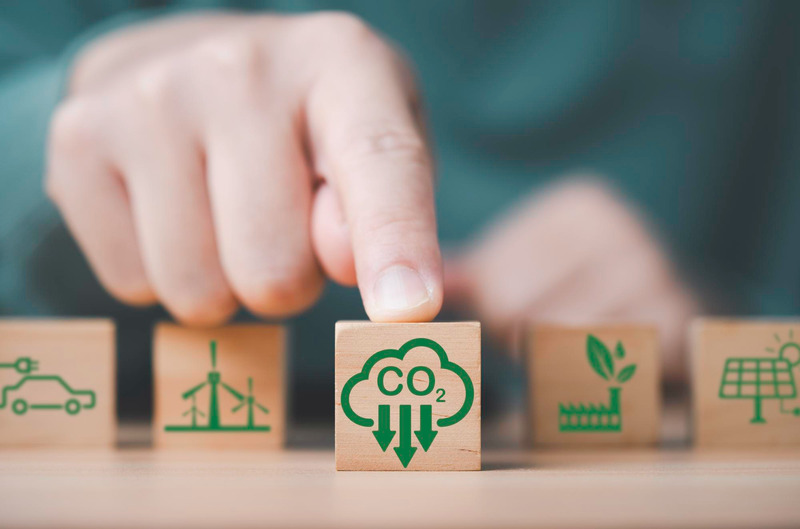Climate change is no longer a distant threat, but a pressing reality. The planet's average temperature is rising, and the consequences – extreme weather events, rising sea levels, and disrupted ecosystems – are already being felt worldwide. While the challenge may seem daunting, individual actions, when combined, can create a significant impact. Reducing your carbon footprint, a measure of the greenhouse gases emitted due to your activities is an empowering step towards a more sustainable future.
The Significance of Reducing Your Carbon Footprint
Our daily choices, from the way we travel to the food we consume, contribute to our carbon footprint. Greenhouse gases, primarily carbon dioxide, trap heat in the atmosphere, leading to global warming. Natural disasters, extreme weather events, and resource scarcity are caused by global warming and therefore it is crucial that we reduce our greenhouse emissions. By reducing our individual carbon footprints, we collectively contribute to lowering overall greenhouse gas emissions and mitigating the effects of climate change.
Every individual action, no matter how small, can contribute to a positive shift. Studies suggest that even a 20% reduction in global greenhouse gas emissions by 2030 is crucial to prevent catastrophic climate change [1]. By adopting simple yet impactful practices in our daily lives, we can collectively contribute to achieving this critical goal.
Simple Everyday Steps to Minimize Your Carbon Footprint
Reducing your carbon footprint, the measure of greenhouse gases emitted through your activities is an impactful way to contribute to a healthier planet. The good news is that reducing your carbon footprint doesn't require drastic lifestyle changes. Here are a few simple, everyday steps you can incorporate into your routine:
1. Transportation Choices:
Embrace sustainable transportation: Opt for public transportation, cycling, or walking whenever feasible. Not only will you reduce your carbon footprint, but you'll also contribute to cleaner air and a healthier lifestyle.
Carpool or utilize ride-sharing services: If driving is unavoidable, consider carpooling with colleagues or friends or utilizing ride-sharing services. This reduces the number of vehicles on the road, minimizing traffic congestion and associated emissions.
Explore electric vehicles: As technology advances and electric vehicles become more accessible, consider switching to an electric car or hybrid model. These vehicles produce significantly lower emissions compared to gasoline-powered counterparts.
Plan your routes efficiently: When driving, plan your trips efficiently to avoid unnecessary detours and traffic jams. This not only saves you time and fuel but also minimizes your carbon footprint.
2. Energy Consumption:
Upgrade to energy-efficient appliances: When replacing appliances, opt for energy-efficient models with high Energy Star ratings. These appliances consume less energy, saving you money on your utility bills and reducing your carbon footprint.
Embrace LED lighting: Replace traditional incandescent bulbs with LED lights. LED lights are significantly more energy-efficient, lasting longer and emitting less heat, ultimately reducing your carbon footprint.
Conserve electricity: Develop mindful habits to conserve electricity in your daily life. Turn off lights and electronics when not in use, unplug chargers and appliances when not in operation, and adjust your thermostat settings to optimize energy use.
3. Food Choices:
Embrace local and seasonal produce: Choose locally sourced, seasonal fruits and vegetables. This will support local farmers and minimize the environmental impact associated with long-distance transportation which reduces fuel consumption and associated emissions.
Support sustainable farming practices: Look for labels indicating sustainable farming practices like organic or fair trade certifications. These labels ensure that food is produced with minimal environmental impact, fostering biodiversity and soil health.
Reduce meat consumption: Animal agriculture contributes significantly to greenhouse gas emissions. Consider reducing your meat consumption and exploring plant-based alternatives. This not only benefits your health, such as decreasing risks for high blood pressure and heart disease, but also helps minimize your carbon footprint[1].
Find more tips on daily habits in environmental sustainability, reducing food waste at home and storing your fruits and veggies. Let’s all play our part in saving the environment.
Nestlé Malaysia: Championing Sustainability
Nestlé Malaysia: Walking the Talk. Just like reducing your individual carbon footprint, we at Nestle Malaysia are committed to sustainable transportation by using renewable energy sources for 100% of our electricity needs. Recognizing the crucial role we play, Nestlé in Malaysia actively implements initiatives to reduce their carbon footprint and contribute to a greener future. Here are two noteworthy examples of our commitment:
1. 100% Renewable Energy: In January 2022, Nestlé Malaysia achieved a groundbreaking milestone by sourcing 100% of its electricity from renewable energy sources [2]. This remarkable achievement signifies their dedication to reducing their carbon footprint and promoting clean energy solutions. Transitioning to renewable energy sources significantly minimizes greenhouse gas emissions associated with electricity generation, contributing positively to combating climate change.
2. Nestlé Net Zero: Building upon their commitment to sustainability, Nestlé Malaysia is actively working towards achieving net zero emissions across its entire value chain by 2050 [3]. This ambitious goal encompasses a holistic approach, including various initiatives:
3. Optimising Logistics: Streamlining logistics and transportation processes helps reduce fuel consumption and associated emissions. This can involve utilizing efficient transportation modes, optimizing routes, and exploring low-carbon alternatives.
4. Reducing Packaging Waste: Implementing sustainable packaging practices like using recycled materials, minimizing packaging size, and exploring innovative, biodegradable solutions minimize environmental impact. Products like the MILO UHT range have switched to paper straws.
5. Sourcing Sustainable Ingredients: Partnering with farmers and suppliers who adopt sustainable agricultural practices like responsible water management, soil conservation, and renewable energy usage contributes to a more sustainable food system. For example, Nescafé has been collaborating with local farmers in Kedah for a more sustainable source of coffee beans.
These are just a few examples of Nestlé Malaysia's dedication to environmental responsibility. By taking inspiration from such initiatives and incorporating the simple everyday steps outlined above, we can all play a crucial role in reducing our carbon footprint and contributing to a more sustainable future for ourselves and generations to come.
Every Action Counts
While the challenges posed by climate change are significant, individual actions, when combined, can create a powerful force for positive change. By embracing sustainable practices in our daily lives, from transportation choices and energy consumption to mindful food habits, we can collectively contribute to reducing our carbon footprint and mitigating the effects of climate change. Remember, every action counts and even small changes can make a significant difference.
Together, let's create a future where a sustainable lifestyle is not just an aspiration, but a reality for all.
Additional Tips:
Conserve water: Implement water-saving practices like taking shorter showers, fixing leaky faucets, and watering your lawn efficiently. This not only helps the environment but will also save you from high water bills in the long run.
Reduce, reuse, and recycle: Minimize waste by reducing your consumption, reusing items whenever possible, and diligently recycling. You can start small like participating in MILO Flip, Flap, Flat.
Educate and inspire others: Share your knowledge and experiences with friends, family, and your community to inspire them to adopt sustainable practices. Extend your reach by posting on social media and setting up a good example as someone who cares for the Earth and future generations.
By incorporating these additional tips and taking inspiration from companies like Nestlé Malaysia who are leading the way in sustainability, we can collectively work towards a brighter and more sustainable future for our planet. Remember, the journey towards a sustainable future begins with each individual's commitment to making a difference. Let's start today, share this article and encourage others to play their part for a better future.







